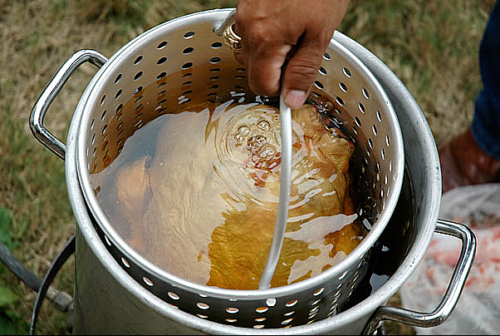Holidays in the south, especially, are never complete without a deep-fried turkey. Drawn in by the promise of delectable, moist, savory turkey meat, deep-frying this classic Thanksgiving staple has grown to become an increasingly popular tradition and safety hazard.
According to the National Fire Protection Association: deep fryer fires cause an average of 5 deaths, 60 injuries, and more than $15 million in property damage each year.
Deep-frying turkeys have certainly become a recipe for holiday tragedy.
Before you fry your bird, learn how to do so safely so that you don’t become a statistic. When it comes to deep-frying turkey, you want to take every precaution to keep your family and your home safe.
Here are a few tips to take note of before you drop your bird in hot oil:
A smaller bird is best. A 10 to 12-pounder does better in a fryer. A larger turkey has to cook longer so there is a greater chance of burning the oil.
Don’t overfill. Never exceed the maximum fill line of a fryer and preheat the oil according to its manufacturer’s suggestion.
Use a thawed and dry turkey. Do not use a frozen turkey! Pat your thawed bird dry inside and out with paper towel, then prepare it as desired with dry seasonings and or an injection of marinades. Word to the wise…do not inject the marinade just under the skin as a water-based marinade will result in the hot oil popping and splattering. Remember to remove the pop-up timer from the breast (if applicable). Do not stuff your turkey with dressing when deep-frying!
Place fryer on level surfaces. Propane turkey fryers must be used outdoors in an open area and placed on level dirt or on a level grassy area. Never place a propane unit on a wooden deck that could catch fire, or on concrete that can be stained by the oil.
Consider an indoor fryer. An indoor electric turkey fryer may be placed on a countertop that is a sensible distance from overhead cabinets.
Don’t plop! Never just plop a turkey into hot oil, slowly lower it to prevent splattering. Be sure to wear long oven mitts on your hands and sport long sleeves to avoid splattering hot oil on your skin.
Peanut oil works best. Speaking of oil, peanut works best. If there is a nut allergy, you can get away with canola. According to the Texas Peanut Producers, peanut oil may be used three or four times to fry turkeys before signs of deterioration begin. Such indications include foaming, darkening, or smoking excessively, indicating the oil must be discarded. Other signs of deteriorated oil include a rancid smell and/or failure to bubble when food is added.
Monitor the temps – Use caution when touching the turkey fryer. The lid and handle can become very hot and can cause burns. Be sure to keep track of the oil’s temperature as many fryers do not have their own thermostats.
Once you’re done frying your bird, carefully remove it from the fryer and check its internal temperature with a food thermometer. The internal temperature should be 165°F to 170°F in the breast and 175°F to 180°F in the thigh.
Be prepared in case of a fire. Have a fire extinguisher (multipurpose, dry-chemical) ready at all times in the event that the oil ignites. And remember, never throw water on an oil fire!!
Remain watchful! Don’t consume alcohol while you are turkey frying. Keep a watchful eye on your fryer. NEVER leave it unattended during the heating, cooking, and cooling process!
